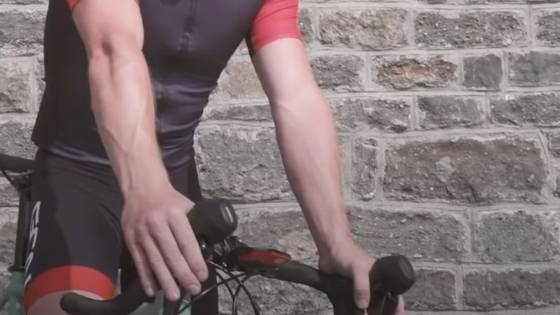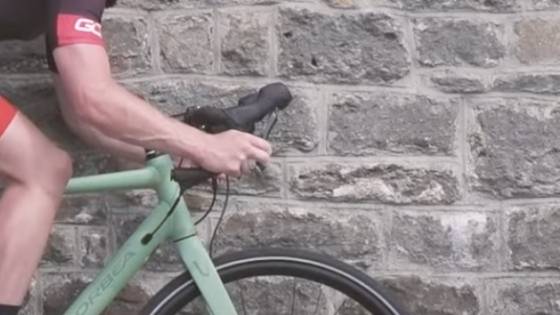I’m sure you’ve noticed that road bike handlebars are curved and in a drop position. There are a few reasons why they’re shaped the way they are, but it’s not just to make your arms more comfortable.
The curve in your handlebars are created for several things: better control, improved grip, and enhanced aerodynamics. And while some cyclists may think this is an unnecessary design detail—it can be difficult to get used to at first—the benefits of the curvature far outweigh the negatives.
But exactly why are road bike handlebars curved?
The handlebars of a road bike are curved to allow for different hand positions, which can help on long rides. The rider will have more control when shifting their hands and body weight, so they don’t get sore, wrists, hands and lower back. Additionally, being aerodynamic also improves with speed.
The first curved dropped handlebar model was the Cinelli Criterium produced in Italy. At that time, it had been used on road racing bikes for more than 10 years. In 1971, the Selle Italia world championship team used dropped handlebars as standard road racing equipment.
In the same year, the dropped handlebars became the official competition shape for all road racing bikes. However, no one seems to know who first thought of how to make a drop handlebar. It is believed that after a race between France and England in 1890, the dropped handlebar was created.
The slight curve adds flexibility so that dropped handlebars don’t feel as rigid as traditional straight bars. When dropped handlebars are used in conjunction with the proper riding position, it will feel as if you are almost lying on your bike when going fast. Dropped handlebars are a great way to get speed while still being able to handle corners.
Table of Contents
What Is The Purpose Of Drop Handlebars?
The entire point of drop handlebars is to reduce wind resistance—or drag—against you by lowering your profile. Changing your hand position to the lower portion of the drop handlebars forces your body to get lower and more aerodynamic.
The drop bars are particularly useful when you’re about to speed up, overtake another cyclist or for going downhill. In fact, drop handlebars are approximately 10 – 15% faster than flat bar handlebars.
It’s also helpful if the wind picks up because your body will be lower, your head will be down, and your body narrower. This allows for the wind to pass over and under you a lot easier. This can make cycling in the wind 20 -30% easier with a drop handlebar.
To discover other ways to get more aerodynamic on your road bike check out this article.
How Do You Ride A Bike With Curved Handlebars?
One of the interesting things about the curved handlebar setup is that you can ride with your hands in many different positions. On a flat bar, you’re limited to one.
1. On Top Of The Rubber Brake Hoods “The Hood”
Riding the hood is the most common hand position for most cyclists because it’s similar to a flat handlebar, which we are all used to riding. It keeps your body upright and boosts confidence on the bike for newer riders.
This is a vertical hand position where you rest your hands on the top of the brakes. On most curved handlebars, the brakes are situated vertically, giving you a good grip position on the top of the brake with the webbing between your thumb and the bottom knuckle of your index finger.

2. Traditional Flat Bar
Even with curved handlebars, you still have a section of flat bar that extends from the stem (head tube). Sure it’s a small, flat section, but if you like riding the traditional way as you would with a flat bar, you can still do that.
Even though this position feels similar to a flat bar, it doesn’t give you much room for your hands and puts your body and arms in a very narrow position. This isn’t great for handling the bike or cornering because you have all the bike’s weight in a weak grip.

3. At The Bottom Of The Drop Bar
Long-distance, competitive riders will often drop their hand position to the bottom of the curved handlebars. It lowers their body profile in the wind and helps them take an aerodynamic advantage when they want to go fast or pass another biker.
Typically more cyclists switch to the lower part of the drop handle if they are going downhill or want to increase the speed over a short distance. This is the most aerodynamic position you can get on a bike and will increase your overall speed. However, it does require the greatest range of flexibility.

4. Somewhere In Between (Ramps)
This is a grip positioned farther above the bottom of the curved handlebars but halfway below the vertical hand brakes. It’s not a very comfortable, long-term position, but some bike riders like it, so it’s there if you need it.
Regardless of the type of hand position you select, there is a good chance you will apply a combination of all the different hand positions on a curved and drop handlebar.
This is why the curve handlebar design is featured on the vast majority of Road bikes. Your versatility in hand positions and the ability to put your body in different positions make a drop handlebar more practical than a flat handlebar.
Benefits Of A Dropped Handlebar On A Road Bike?
The primary reason behind the curved handlebars is to allow for a variation of grips, notably for long-distance travel, because changing grips brings a level of comfort. It’s also a slight advantage over straight handlebars in terms of aerodynamics.
Dropped handlebars (drop bars) are shaped like a ‘U’ and allow for riders to use multiple positions. Riders can choose whether they want to sit up straight or lean slightly forward. The dropped shape also allows them to easily keep their hands on the bar at all times, even while climbing or going downhill.
It’s not the handlebars’ shape that gives you more of an aerodynamic advantage, but how you grip the curved handlebars. Positioning your hands on the bottom of the curve allows you to lean forward without having to extend out your elbows.
It’s a far more comfortable position when you situate your body to have a lower profile. The lower curve of the handlebars allows you to do that without becoming very uncomfortable and having to use your chest muscles to maintain your low-profile position.
This has led to incredibly sleek and fast bikes that are able to perform at the highest level. Therefore, the main advantage of curved and drop bars are speed, distance and overall power output.
Disadvantage Of Dropped Handlebars On Road Bikes?
The dropped handlebars do have a downside, however. The lower body position required to hold the deeper curved handlebars needs more flexibility in the legs and lower back.
This type of riding position is challenging, especially over a longer distance, and it’s not the most suitable position for people with lower back pain or knee problems.
Furthermore, the dropped handlebar isn’t ideal for city cycling or commuting. The handlebars aren’t as stable when turning fast to avoid cars or pedestrians.
If you are a beginner cyclist or use your road bike for commuting, wearing a backpack on a bike with curved handlebars puts more pressure on joints and lower back muscles. Therefore, you may prefer the upright position that a flat handlebar provides but still have the speed of a road bike.
Can You Put Straight Handlebars On A Roadbike?
You can change your curved handlebars to straight ones on a road bike if you don’t feel comfortable with drop handlebars. However, it’s not as easy to fit and you’ll have to do measurements and make sure that you can fit your gear and brake system on a new set of handlebars.
- Take Stem Measurements
- Pick out flat bar brakes
- Pick out flat bar shifters
- Select some new grips
Measuring the bike stem is paramount before deciding on a new set of flat handlebars. Getting a proper measurement on the fitting will ensure that the handlebars you choose will be as quickly plug-and-play as possible. You also don’t want to end up with handlebars that fit the stem properly but look ludicrously large or small compared to the rest of the bike’s frame.
Of course, you’ll have to replace the brakes. They probably won’t be compatible with a flat bar setup. It’s also a good idea to measure how long the cable runs are to both your front and rear brakes.
It’s a safe bet that the cables will be long enough, but you don’t want to go too long. When you’re searching, be sure to include the type of bike you’re purchasing the brakes for within the search parameters.
You’ll need to do the same thing with the flat bar shifters. Not only will they need to be compatible, but you need to order the kind of shifters that have the same gear range that your chains rings do.
You’ll also want some new grips. It’s possible that they’ll come with the handlebars, but that’s not always the case. Besides, you may want to go with something that is a better fit for your personality.
